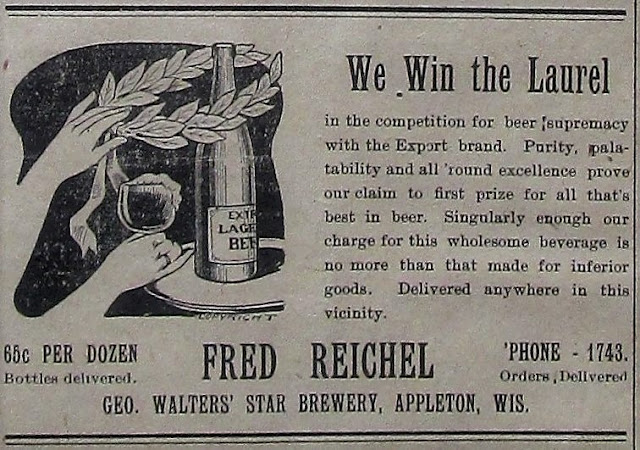By Lyle Hansen
January 1, 1909
Wigger's delivery team
took advantage of the absence of the driver a few mornings ago and came down
town at a lively pace. Upon reaching the Union Bag and Paper Company's mill at
the foot of the Wisconsin Avenue the sleigh was capsized and from there on the
street was strewn with bread, rolls,
cream puffs, cookies, etc. Many pedestrians took advantage of the situation and
helped themselves to lunch. The team was captured just after it had crossed the
bridge.
January 8, 1909
The Union Bag and Paper
Company’s mill is running with a full day force and since election business has
so improved that the company has put on a night crew and is operating quite a
number of bag machines every night. They are also running their entire
automatic bag forming machines for the first time in two years. Now all hands
are at work. A year ago, less than half of the day crew was employed and no one
at night.
A resolution was passed
ordering the Kaukauna Gas, Electric Light and Power Company to continue to
furnish fifty-three all night arc lights for street lighting for a period of
ninety days at an advance of $5.00 per light or $65.00 per light per annum. The
council still has the light question under consideration and is again looking
into feasibility of municipal ownership.
January 15, 1909
Alonzo E. Horton, 95 years of age, founder of the village of Hortonville in
Outagamie County and the city of San Diego, California. He was one
of the oldest settlers in Outagamie County, locating where the village of
Hortonville now stands in the early 1840's.
Last Saturday morning
Henry Vandenberg of West Holland died at the age of 75. Henry was one of the
earliest pioneers in this area. He came here with his parents at the age of 14
in 1848 when they accompanied Fr. Vandenbroek from Holland to Little Chute. He
would recall the early days in this territory as he helped his family carve a
home out of the dense forest which covered this land. He recalled walking to
Green Bay and back home carrying food through the pathless woods. He worked at
many jobs throughout his life time. He ran a ferry in Kaukauna before there
were bridges across the river. He worked at the Grignon’s grist mill and when
the government began to construct the dams and canals in 1853 he worked several
years on that project. He married Odelia Vanderheyden and settled on a farm
they had eleven children. Henry enlisted with the Wisconsin Regiment in the
Civil War and served in the front lines. It is hard to enumerate all the acts
this early day pioneer endured. When
crops failed to provide for his family he split and shaved shingles from the
white pine trees for homes. Henry was a very industries person. Last year at the Memorial Day exercises he
was a guest of the Grand Army Post and with a rich fund of anecdotes he
entertained the comrades on that day as they smoked after dinner cigars.
January 22, 1909
The formation of ice at
the upper rapids made it necessary for pulp manufacturers to resort to dynamite
in dislodging it in order to get water to operate their plants.
A spectacle presented
by Eugene DeBruin of Thorp Tuesday. While driving down Lawe Street with a horse
and cutter the runner caught the interurban track and tipped him from the
cutter. Mr. DeBruin clung to the reins until they broke but not before being
dragged some distance. What a sight he
was slush from head to toe.
January 29, 1909
Recent heavy rains have
caused the ice in Lake Winnebago to break up and come down the river in
quantities that threaten to take out the Menasha Bridge.
The referendum passed in
1906 states that starting in 1912 no person may vote in this state that is not
a naturalized citizen. Therefore, it is reasonable to expect there will be a
great rush to complete these papers. Under the law all persons becoming
citizens must be able to write their full name and to speak the English
language. The person must furnish a certificate of landing secured from the
immigration office at which they enter the country.
1909 - Child labors in the cotton mills.





No comments:
Post a Comment